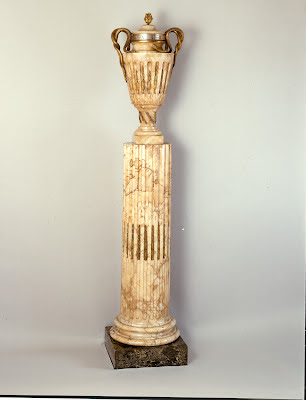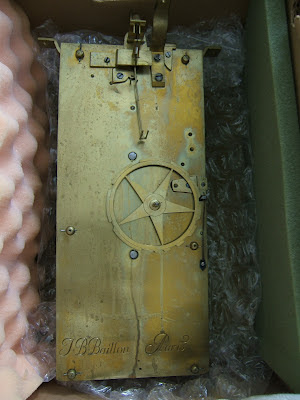This week we turn the blog over to one of our summer collections interns: Julie Carlsen.
————————————————————————
As a new collections intern here at the Rosenbach, I have
the pleasure of getting to explore the incredible collections. Today, I
want to take a moment of your time to look at one of my favorite pieces- a
decorative orbital clock created by Jean Baptiste Baillon. A Louis XVI ormolu mounted,
marble, vase shaped clock, this object at first appears to be a statue or other
ornate structure because of its size and stature. However, part of why I love
this piece that its strong physique is complimented by delicate details.This clock stands over six feet in height and is made out of
alabaster marble. The urn on top of the stand houses the clock. The snakes on
either side, which serve as the handles, also have tongues that indicate the
minute and hour, which are displayed on rotational cuffs that spin around the
top of the urn.
the pleasure of getting to explore the incredible collections. Today, I
want to take a moment of your time to look at one of my favorite pieces- a
decorative orbital clock created by Jean Baptiste Baillon. A Louis XVI ormolu mounted,
marble, vase shaped clock, this object at first appears to be a statue or other
ornate structure because of its size and stature. However, part of why I love
this piece that its strong physique is complimented by delicate details.This clock stands over six feet in height and is made out of
alabaster marble. The urn on top of the stand houses the clock. The snakes on
either side, which serve as the handles, also have tongues that indicate the
minute and hour, which are displayed on rotational cuffs that spin around the
top of the urn.
Created in the mid-18th century, this clock is
indicative of the art and historical trends at the time. The marble columns are
true to the neoclassicist preferences at the time. Similarly, the wealthy in
France at this time went to extreme lengths to show their wealth, as the
embellishment on this clock demonstrates.
indicative of the art and historical trends at the time. The marble columns are
true to the neoclassicist preferences at the time. Similarly, the wealthy in
France at this time went to extreme lengths to show their wealth, as the
embellishment on this clock demonstrates.
 |
| Jean Baptiste Baillon. Orbital clock. Rosenbach Museum & Library. 1954.2017 |
Almost as impressive as our clock is the history
of its maker. Jean Baptiste Baillon III was one of the most prestigious horologists
in the 18th century and is still famous today for his intricate clocks and
watches.
of its maker. Jean Baptiste Baillon III was one of the most prestigious horologists
in the 18th century and is still famous today for his intricate clocks and
watches.
He was born in France in the early 18th century into
a family of horologists (Baillon’s father, grandfather, and son all made luxury
French clocks). In 1727, he was received
as a maître horloger in
Paris, and continued to practice his art until he died around 1770. In addition to his horology, Baillon was
known for his business skills, and his large private factory in
Saint-German-en-Laye was famous in its time for its size and efficiency.
a family of horologists (Baillon’s father, grandfather, and son all made luxury
French clocks). In 1727, he was received
as a maître horloger in
Paris, and continued to practice his art until he died around 1770. In addition to his horology, Baillon was
known for his business skills, and his large private factory in
Saint-German-en-Laye was famous in its time for its size and efficiency.
Today, his work is still revered and continues to be
displayed in museums around the world, including the Musée du Louvre, the
Château de Versailles, the Metropolitan Museum of Art, and the Rosenbach Museum
and Library! His watches are the most popular items, although some institutions
also own Baillon clocks. Our clock is especially unique because it stands
alone. Many of the other clocks available to the public via museum collections
are smaller and meant to hang on the wall or stand on a table or mantel.
displayed in museums around the world, including the Musée du Louvre, the
Château de Versailles, the Metropolitan Museum of Art, and the Rosenbach Museum
and Library! His watches are the most popular items, although some institutions
also own Baillon clocks. Our clock is especially unique because it stands
alone. Many of the other clocks available to the public via museum collections
are smaller and meant to hang on the wall or stand on a table or mantel.
In addition to
serving wealthy Parisians, Baillon was also the clockmaker of choice for the
French and Spanish royal families. In fact, Marie Antoinette loved Baillon’s
work so much that she appointed him to the position of Premier Valet de Chambre-Horologer Ordinaire de la Dauphine, or her
own personal horologist. At first I
wrote this fact off as symptomatic of Marie Antoinette’s love of finery, but
after taking a closer look at some of his work, I understand why she purchased Baillon’s clocks. Baillon’s clocks were not just supremely functional- they
were works of art. Accordingly, each part
of the clock is intricate and ornate- even the inside:
serving wealthy Parisians, Baillon was also the clockmaker of choice for the
French and Spanish royal families. In fact, Marie Antoinette loved Baillon’s
work so much that she appointed him to the position of Premier Valet de Chambre-Horologer Ordinaire de la Dauphine, or her
own personal horologist. At first I
wrote this fact off as symptomatic of Marie Antoinette’s love of finery, but
after taking a closer look at some of his work, I understand why she purchased Baillon’s clocks. Baillon’s clocks were not just supremely functional- they
were works of art. Accordingly, each part
of the clock is intricate and ornate- even the inside:
 |
| Jean Baptiste Baillon. Orbital clock mechanism. Rosenbach Museum & Library. 1954.2017 |
Baillon was not just trying to put a pretty face on a
functional device- he truly made clocks like art. When I first came across the
term “horologist,” I wondered if clockmakers really need such a fancy title,
but, Jean-Baptiste Baillon is proof that they do.
functional device- he truly made clocks like art. When I first came across the
term “horologist,” I wondered if clockmakers really need such a fancy title,
but, Jean-Baptiste Baillon is proof that they do.

